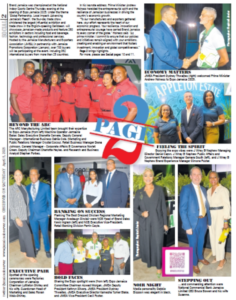Taking tourism to the hills
Three children race around a telephone pole guy wire at the Springside Grill and Tea Shop while adults play Ludo on the arched verandah. Food is grilling on a brazier atop a side table in the rocky yard. The cookshop, open barely a week when the Jamaica Observer visited, is run by four brothers, including the irrepressible Michael Brown, who greets his guests with a rap about Jamaica’s manifold attractions.
We’re on Robbins River Road, the main thoroughfare of Beeston Spring, midway between Whitehouse, Belmont and Savanna-la-Mar. In most respects, it’s a quiet rural drive, but it has entrepreneurial ambitions. From barkeeps to bee-keepers, the residents of this Westmoreland village are determined to get ahead.
Beeston Spring is the showcase for a new programme called Villages as Businesses, an attempt to boost development through community tourism. Nabs Bee Farm is our first stop, where soft-spoken former cabinet maker Roan Saunders introduces us to his 90 blue-and white colonies, which together produce a 45-gallon drum of honey a year. “I want to build an extraction room,” he says. An adjacent observatory would allow tourists to watch in safety as Saunders removes honey-filled frames from the hives.
Seven other villages — Resource, Treasure Beach, Axe-n-Adze, Belmont, Camrose, Albert Town and Charles Town — are also participating in the pilot project. Another 30 are waiting in the wings, and the organisers are convinced there’s long-term potential for hundreds more.
Villages as Businesses was awarded $13 million for training and development from the Jamaica Social Investment Fund late last year. And the business development officer of the National Association of Jamaican and Supportive Organisations has invited it to identify suitable projects worth a minimum of US$15 million ($1.3 billion) in total, though so far it has proposals worth only US$500,000.
To qualify for that investment, the organisation recently appointed a new chairman, Professor Ian Boxill of the University of the West Indies, who, with the assistance of his graduate students, will help the nascent entrepreneurs write up business plans.
Some of the businesses on Robbins River Road are better equipped for this than others. Khalisah Callam, a recent returnee to Jamaica, spent more than a decade in the US, much of it working as a fashion design director in New Jersey.
Her plans to add a 50-seat tea salon to her new home are well under way. The US$20,000 project should be complete by December and will employ four people. “I have experience in business and management,” she says. “And I’ve been researching this for the past three years.”
The Villages as Businesses programme is part of the Country-style Community Tourism Network (CCTN) run by Diana McIntyre-Pike. For many years, CCTN has tried to attract tourists away from the beaches to explore Jamaica’s rural heartland, discovering what it’s like to live in small villages. Villages as Businesses will carry on this work, using tourism to support family businesses, which can then grow big enough to think about selling to other parts of the island and one day, perhaps, exporting to the wider world.
The catch is that few tourists have come visiting so far. Most participants put the figure in dozens and none said they’d had more than 100. And it’s not clear how many tourists really want to give up time in the cabana to drive for hours on Jamaica’s crumbling mountain roads. While some upscale resorts reported recently that rich tourists are looking for more socially responsible ways to spend their time on holiday, the pull of sand, sea and sun in the mid-market is still strong.
Exceptional tourists may decide that they want to take advantage of home-stay accommodation in the village, possibly rooming in the yellow house with the broad verandahs built by Robert Brown, an architect, and now occupied by his son’s family.
It has three rooms available, all looking out down the hillside. Guests eat with the family and sometimes enjoy entertainment by a mento band, another Villages as Businesses enterprise. “We’re just getting involved with the movement,” says Brown as he potters around his garden. “We’ve had 12 persons so far.”
Some of the businesses clearly need a lot of development before they’re of showcase quality. The spice processor at Beeston Spring has an electric grinder in her driveway for turning dried turmeric rhizomes into powder, but it looks like more of a hobby than a living and is certainly not exciting enough to satisfy the bored teens in a typical North American family.
On the other hand, Rena Lawrence’s 3R community bar, named after her sons Ray, Raj and Rudy, is both authentic and enticing, with an impromptu band playing on the verandah. Unfortunately, we have to leave all too soon to get spicy vegetable soup from another cookshop on the way down the hill.
Villages as Businesses will never have the polished look of tourist enterprises on the North Coast, but it adds a new dimension to the experience of Jamaica’s foreign visitors, and has at least the potential to spread the wealth wider and deeper. Perhaps more importantly, though, it’s equipping persons with the skills to start their own businesses as well as the belief that they can succeed.















